Q1: Define Beam.
Ans:The property of a material by which it returns back to its original position after the removal of external force is called elasticity.
Q2: Enlist different types of a beam.
Ans:
The types are:- ➔ Statically Determinate Beam
- ➔ Simply supported beam
- ➔ Overhanging beam
- ➔ Cantilever beam
- ➔ Statically Indeterminate Beam
- ➔ Propped supported beam
- ➔ Fixed beam
- ➔ Continuous beam beam
Q3: Sketch any 4 types of beams.
Ans:

Q4: What is meant by a statically determinate beam?
Ans:A beam which supports reactions can be calculated by using the equation of static equilibrium is a statically determinate beam.
Q5: Define a statically indeterminate beam.
Ans:A beam which supports reactions cannot be calculated by using the equation of static equilibrium is a statically indeterminate beam.
Q6: Differentiate between cantilever beam and propped beam.
Ans:
A beam having fixed support at one end and simple support at the other end is a propped beam.
A beam in which one end is fixed and the other end is free is a cantilever beam.
Q7: Define simply supported beams.
Ans:
A beam having simple supports at both ends is a simply supported beam.
Q8: Define a simple beam.
Ans:A simply supported beam is known as a simple beam. A beam having simple supports at both ends is a simple beam.
Q9: Define a fixed beam.
Ans:
A beam having fixed support at both ends is a fixed beam.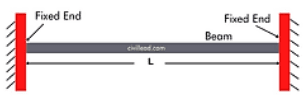
Q10: What do you know about continuous beams?
Ans:
A beam having more than two simple supports is called a continuous beam.
Q11: What is an overhanging beam?
Ans:
A simply supported beam extending beyond the supports is called overhanging beam.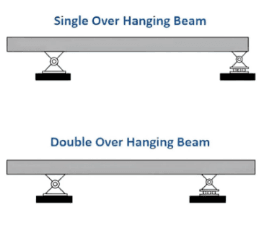
Q12: What do you know about support?
Ans:A beam rests on supports.
Q13: Define reaction.
Ans:Supports provide reacting forces against the applied load known as reactions.
Q14: What are applied loads?
Ans:The external forces acting on a structural member is applied load.
Q15: Enlist different types of supports.
Ans:
The types are:- ➔ Simple Support
- ➔ Roller Support
- ➔ Hinged Support
- ➔ Linked Support
- ➔ Fixed Support
Q16: Define Simple supports.
Ans:Roller and Hinge supports are known as simple supports. These supports do no resit rotation/moment of the member.
Q17: Define Roller Support.
Ans:
A support that provides only one reaction i.e. resistance against perpendicular displacement is a roller support.
Q18: Define Hinge Support.
Ans:
A support that provides two reactions i.e. resistance against horizontal displacement, resistance against vertical displacement is a hinge support.
Q19: Define Fixed Support.
Ans:
A support that provides three reactions i.e. resistance against horizontal displacement, resistance against vertical displacement and resistance against moment is a fixed support.
Q20: Sketch different types of supports.
Ans:

Q21: Define Load.
Ans:The external force acting on a structural member (beam, column, slab etc.) is called Load.
Q22: Write down units of load in different measuring systems.
Ans:
| Systems | Load |
|---|
| MKS | kg |
| CGS | g |
| FPS | lbs |
| SI | N |
Q23: Enlist different types of loads.
Ans:
The types are:- ➔ Point Load
- ➔ Distributed Load
- ➔ Uniformly Distributed Load (U.D.L)
- ➔ Varyingly Distributed Load (V.D.L)
- ➔ Triangular Load
- ➔ Trapezoidal Load
- ➔ Couple
Q24: Define Point Load.
Ans:
The load acting on a point (very small span or area) is called point load or concentrated load. It is represented by an arrow.
Q25: What is meant by a couple?
Ans:
When two and opposite forces are applied to a body they form a couple.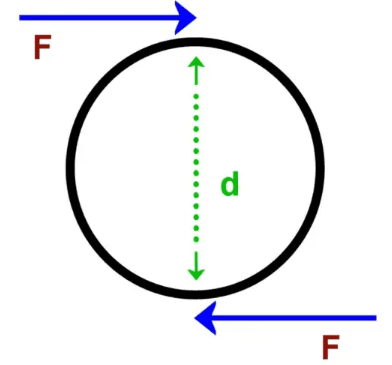
Q26: What is meant by a couple arm?
Ans:The distance between two forces forming a couple is called a couple arm. It is represented by d.
Q27: Define distributed load.
Ans: The load distributed over a span is called a distributed load.
Q28: Enlist different types of distributed load.
Ans:
The types of distributed loads are:- ➔ Uniformly Distributed Load (U.D.L)
- ➔ Varyingly Distributed Load (V.D.L)
- ➔ Triangular Load
- ➔ Trapezoidal Load
Q29: Define UDL.
Ans:
A UDL is a Uniformly Distributed Load. It is a type of load that is equally divided over the span i.e. each point of the span has the same amount of load.
Q30: Define VDL.
Ans:
A VDL is a Varyingly Distributed Load. It is a type of load that is unequally divided over the span i.e. each point of the span has a different amount of load. The starting point has zero load and slowly the load increases and reaches maximum at the other point.
Q31: Define ECL.
Ans:ECL is Equivalent Concentrated Load. For calculations, a UDL is first converted into a point load called ECL. The formula to calculate ECL is:
ECL = UDL x Loaded Length
Q32: Define triangular load.
Ans:
s. A triangular load is a type of varyingly distributed load in which the starting point has zero load and slowly the load increases and reaches maximum at the other point. 
Q33: Define trapezoidal load.
Ans:
A trapezoidal load is a combination of both UDL and Triangular load, forming a trapezoid.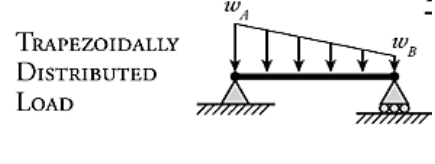
Q34: What is meant by span of the beam?
Ans:The length of the beam is known as the span of the beam.
Q35: Differentiate between clear span and effective span.
Ans:
The centre-to-centre distance between two supports is called Effective Span while the internal distance between two supports is called clear span.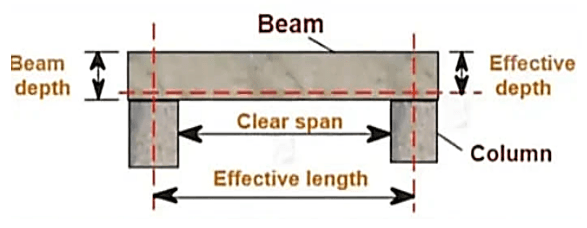
Q36: Define moment of force.
Ans:
The turning effect of a force is called moment of force or torque.
Torque = Force x Distance
Q37: Write down units of moment in different measuring systems.
Ans:
| Systems | Moment |
|---|
| MKS | kg-m |
| CGS | g-cm |
| FPS | lbs-ft |
| SI | N-m |
Q38: What is the difference between clockwise moment and anti-clockwise moment?
Ans:The moment produced just like the moving direction of the clock is a clockwise moment while the moment produced opposite to the moving direction of the clock is an anti-clockwise moment. Usually, the clockwise moment is taken +ve and anticlockwise moment is taken -ve.
Q39: Define shear force.
Ans:The algebraic sum of all the vertical forces at any section of a beam to the right or left of the section is known as shear force.
Q40: Define shear force diagram.
Ans:A shear force diagram (SFD) visually represents the variation of shear force along the length of a structural member, such as a beam.
Q41: Define bending moment.
Ans:The algebraic sum of all the moments of all the forces acting to the right or left of the section is known as bending moment.
Q42: Define bending moment diagram.
Ans:A bending moment diagram (BMD) visually represents the variation of bending moments along the length of a structural member, such as a beam.
Q43: Define point of contraflexure.
Ans:
The points of contraflexure (or inflection) are points of zero bending moment, i.e. where the beam changes its curvature from negative to positive or vice versa. It mostly occurs in overhanging beams.
Q44: Define sagging or sag.
Ans:
A positive bending moment is called Sag or sagging.
Q45: Define hogging or hog.
Ans:
A negative bending moment is called Hog or hogging.





















